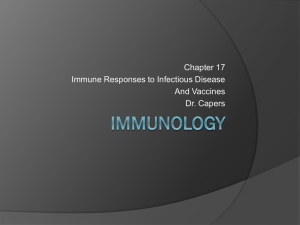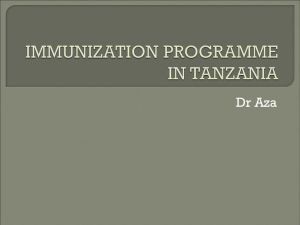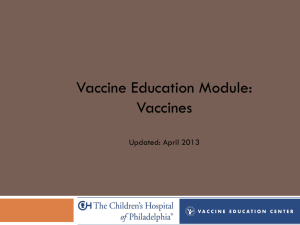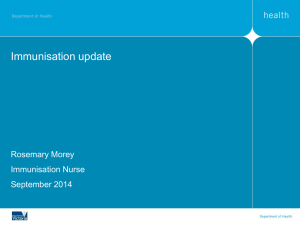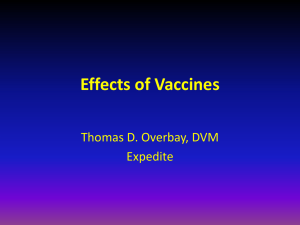Vaccines - e-Bug
advertisement
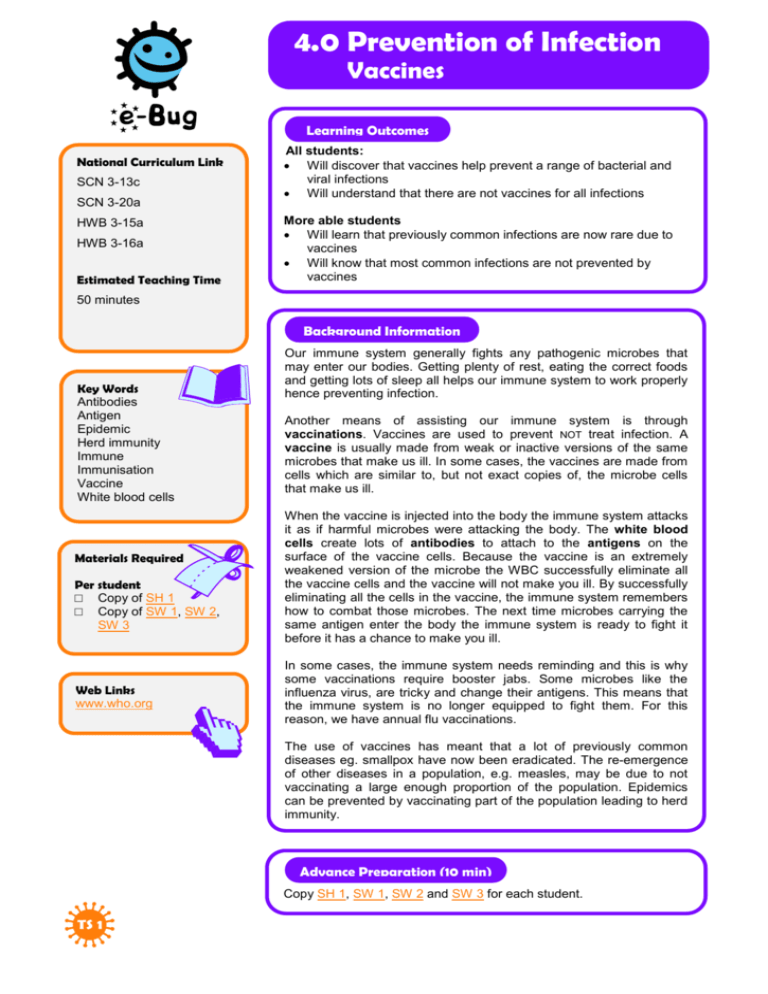
4.0 Prevention of Infection Vaccines Learning Outcomes National Curriculum Link SCN 3-13c SCN 3-20a HWB 3-15a HWB 3-16a Estimated Teaching Time All students: Will discover that vaccines help prevent a range of bacterial and viral infections Will understand that there are not vaccines for all infections More able students Will learn that previously common infections are now rare due to vaccines Will know that most common infections are not prevented by vaccines 50 minutes Background Information Key Words Antibodies Antigen Epidemic Herd immunity Immune Immunisation Vaccine White blood cells Materials Required Per student □ Copy of SH 1 □ Copy of SW 1, SW 2, SW 3 Web Links www.who.org Our immune system generally fights any pathogenic microbes that may enter our bodies. Getting plenty of rest, eating the correct foods and getting lots of sleep all helps our immune system to work properly hence preventing infection. Another means of assisting our immune system is through vaccinations. Vaccines are used to prevent NOT treat infection. A vaccine is usually made from weak or inactive versions of the same microbes that make us ill. In some cases, the vaccines are made from cells which are similar to, but not exact copies of, the microbe cells that make us ill. When the vaccine is injected into the body the immune system attacks it as if harmful microbes were attacking the body. The white blood cells create lots of antibodies to attach to the antigens on the surface of the vaccine cells. Because the vaccine is an extremely weakened version of the microbe the WBC successfully eliminate all the vaccine cells and the vaccine will not make you ill. By successfully eliminating all the cells in the vaccine, the immune system remembers how to combat those microbes. The next time microbes carrying the same antigen enter the body the immune system is ready to fight it before it has a chance to make you ill. In some cases, the immune system needs reminding and this is why some vaccinations require booster jabs. Some microbes like the influenza virus, are tricky and change their antigens. This means that the immune system is no longer equipped to fight them. For this reason, we have annual flu vaccinations. The use of vaccines has meant that a lot of previously common diseases eg. smallpox have now been eradicated. The re-emergence of other diseases in a population, e.g. measles, may be due to not vaccinating a large enough proportion of the population. Epidemics can be prevented by vaccinating part of the population leading to herd immunity. Advance Preparation (10 min) Copy SH 1, SW 1, SW 2 and SW 3 for each student. 4.0 Prevention of Infection Vaccines Introduction (15 min) 1. Begin the lesson by asking students which vaccines/immunisations they have had e.g. polio, MMR, TB or any holiday vaccinations and if they know what the vaccines were for. 2. Highlight that immune means resistant to disease and that ‘immunisation’ is a way of raising the body’s immunity to both bacterial and viral disease. 3. Explain that vaccines/immunisations are a harmless small amount of the microbe/disease outer coat which teaches our body how to fight the bad microbe when or if we get attacked by the disease. 4. Explain how vaccines work (outlined in TS 1) with the help of SH 1. Explain that antibodies pass from mother to child through breast milk and this helps protect newborn babies from disease. 5. Remind students that microbes can change their outer coats very quickly and that some microbes do this so quickly that scientists cannot create vaccines for every infection or have to make a new vaccine every year, like the flu vaccine. 6. Main Activity (35 min) 1. This activity is best completed in groups of 2 – 3 students. 2. Provide each student with a copy of SH 1 and SW 1, SW 2 and SW 3. 3. Ask the class what they know about the measles? Explain that measles is a highly contagious vaccinepreventable disease caused by the measles virus. Measles is one of the most easily spread diseases but also the most deadly of all childhood rash/fever illnesses. 4. The World Health Organisation (WHO) examines, records and reports on all health related incidents across the globe and produces guidelines and recommendations to help prevent infectious disease epidemics. The incidence of deaths across the world due to measles was so high that in the 1980s WHO member countries set up national immunisation services in an attempt to eradicate the disease. 5. Tell the class that the table in SW 1 is taken from data collated by WHO, students must manipulate the data using the equation provided to an incidence per 1000 population. By doing this, students can then compare the incidence of disease between the European and African regions being examined. 6. Provide the class with SW 2, here the groups should create a bar chart using their data illustrating the incidence of documented measles cases in both the WHO Europe region and WHO Africa region. Discuss with the class the trend of measles cases over the years within each region but also between the two regions. Ask students to highlight the most obvious points / trends. 7. Provide each group with a copy of SW 3, and ask them to answer the questions as a group. When complete, discuss the answers with the class. a. In the 1980s, The World Health organisation (WHO) reported an increasing number of countries establishing national immunisation services with increasing immunisation coverage in these countries. When do you think these immunisation programmes peaked in the Europe and Africa regions. The sharp decline in the incidence of measles cases between 1990 and 2000 suggest that the immunisation programmes peaked in Europe during the 1990s. In Africa we see 2 cases of decline, the implementation of programmes in the 1990s caused the initial decline however in 2003 and 2006 the measles vaccine coverage was improved causing the second and third decline. b. Can you think on a reason why there are more outbreaks of measles in Africa than in Europe? The immunisation programme was better implemented and followed in the European region than in the Africa region with more people becoming vaccinated. 4.0 Prevention of Infection Vaccines Main Activity (35 min) c. What issues stop the measles vaccine getting to all the people in Africa? War, poverty, suspicion, lack of health education, lack of government good will and lack of infrastructure, difficulty delivering the vaccines, and misinformation regarding vaccines all prevent the vaccines getting to the people who need it. d. What happens when the measles vaccination drops to a low level within a population? When the vaccination drops to a low level, people start contracting the disease again leading to a re-emergence of the disease. e. Why is vaccination not only a personal health issue but also a public health issue? Many infectious diseases are extremely contagious, we can vaccinate ourselves against the disease but other people can contract the disease and spread it further to unvaccinated people. If more people are vaccinated the disease is prevented from circulating. This is why herd immunity prevents epidemics. In today’s society where global travel is relatively cheap and easy an infected person can carry a disease across the world within 24 hours. Herd immunity prevents the epidemics. f. What needs to be done to completely eliminate an infectious disease? A vaccination programme which reaches all target groups on a wide-spread continual basis is the only means to completely eliminate a disease. However, it is not possible to eliminate all disease in this manner as some infectious diseases e.g. avian flu, have other reservoirs outside humans. g. Why hasn’t the flu vaccine eliminated the influenza virus? A vaccine works by tricking the body into making antibodies to combat a particular infectious disease, these antibodies then attach themselves to the antigens in the outer coat of the virus. The influenza virus however mutates and changes its outer coat faster than scientists can create appropriate vaccines. h. Why is a vaccine regarded as a preventative measure and not a treatment? Vaccines are used to boost the body’s immunity so that when an infectious disease does enter the body, the immune system is ready to fight it preventing the establishment of disease. Extension Activity 1. Provide the class with a copy of SW 3. 2. Each student should look examine the world map provided and highlight on the map which vaccines are required to visit which countries. Students should also name the disease the vaccine protects against and the microbe that causes this disease. Information can be found at www.who.org, www.traveldoctor.co.uk or by visiting their local medical centre. Teacher Answer Sheet 1 Using the data in SW 1 complete the following table and graph: Number of reported cases of measles per 1000 Year 100 Title 1990 Europe 449.5 Africa 942.1 2000 41.7 775.2 2002 51.8 406.2 2003 31.1 558.5 2004 32.4 469.3 2005 40.9 416.9 2006 57.6 127.8 Reported incidence of measles per 1000 population for WHO Europe and Africa 90 In order for other people to be able to read your results, it is important that the graph has a title that describes the graph contents and that the X and Y axis are labelled appropriately. Reported cases of measles per 1000 population 80 70 60 50 40 LABEL 30 Legend 20 Africa Region Europe Region 10 0 1990 2000 LABEL 2002 2003 Year 2004 2005 2006 Fact Sheet The immune system is our main defence against any pathogenic microbes. Exercise, rest and a balanced diet all help our immune system work properly and prevent infection. Vaccinations can also help our immune system. They are used to prevent NOT treat infection by stimulating the immune system to recognise and destroy the disease causing microbe. Vaccines are a weak or inactive version of the pathogenic microbe. The immune system attacks the vaccine thinking it is a harmful microbe. The white blood cells create lots of antibodies which attach to the antigens on the surface of the vaccine cells. The antibodies destroy all the vaccine cells before it can make you ill. The antibodies then stay in the blood stream for many years, waiting to attack and destroy the real pathogenic microbes if they ever enter the body. Some microbes like the flu, are tricky and change their antigens. This means that the immune system can’t remember how to fight them. For this reason, We have annual flu vaccinations. The use of vaccines has meant that a lot of previously common diseases eg. Smallpox have now been eliminated. While a vaccine protects an individual an infectious disease will only be eradicated if vaccines are used on a wide-spread population wide basis. This is known as herd immunity. Epidemics can be prevented by herd immunity. The data below details the population and reported cases of measles in the regions Europe and Africa, as recognised by the World Health Organisation. This information is usually documented as reported cases per 1000 population for comparison purposes. In the third column, calculate the number of reported cases per 1000 population using the following equation: B / (A / 1000) where A = population in thousands and B = reported measles cases. WHO Europe Region Population in thousands Year 1990 522 443 Reported measles cases 234 827 2000 895 997 37 421 2002 901 440 46 714 2003 904 883 28 199 2004 908 411 29 503 2005 911 776 37 332 2006 915 553 Population in thousands Reported cases/1000 population 52 765 WHO Africa Region Year 1990 510 853 Reported measles cases 481 204 2000 670 918 520 102 2002 705 094 286 380 2003 722 580 403 572 2004 740 358 220 732 2005 758 439 316 224 2006 776 830 99 339 Reported cases/1000 population Using the data in SW 1 complete the following table and graph: Number of reported cases of measles per 1000 Year Europe Africa 1990 2000 2002 2003 2004 2005 2006 Title 100 90 In order for other people to be able to read your results, it is important that the graph has a title explaining what you are trying to show and that the X and Y axis are labelled appropriately. 80 70 60 50 40 30 LABEL Legend 20 10 0 1990 2000 LABEL 2002 200 3 2004 2005 2006 Conclusions 1. In the 1980’s the World Health Organisation (WHO) reported an increasing number of countries establishing national immunisation services with increasing immunisation coverage in these countries. When do you think these immunisation programmes peaked in the Europe and Africa regions. Provide a reason for your answer. _________________________________________________________________________ _________________________________________________________________________ _________________________________________________________________________ _________________________________________________________________________ 2. Can you think on a reason why there are more outbreaks of measles in Africa than in Europe? _________________________________________________________________________ _________________________________________________________________________ 3. What issues stop the measles vaccine getting to all the people in Africa? _________________________________________________________________________ _________________________________________________________________________ _________________________________________________________________________ 4. What happens when the measles vaccination drops to a low level within the population? _________________________________________________________________________ _________________________________________________________________________ _________________________________________________________________________ 5. Why is vaccination not only a personal health issue but also a public health issue? _________________________________________________________________________ _________________________________________________________________________ _________________________________________________________________________ 6. What needs to be done to completely eliminate an infectious disease? _________________________________________________________________________ _________________________________________________________________________ 7. Why hasn’t the flu vaccine eliminated the influenza virus? _________________________________________________________________________ _________________________________________________________________________ _________________________________________________________________________ 8. Why is a vaccine regarded as a preventative measure and not a treatment? _________________________________________________________________________ _________________________________________________________________________ _________________________________________________________________________ In the boxes provided, compile a list of vaccines required, if any, to visit each of the regions on the map. Canada: Western Europe: Russia: Far East: Asia: S. America: Africa: Australia:


